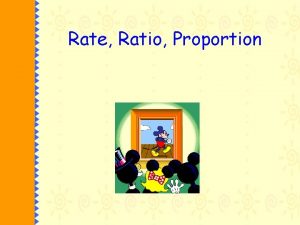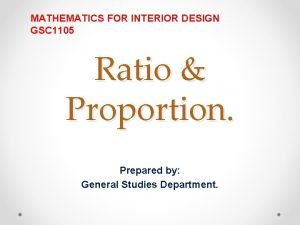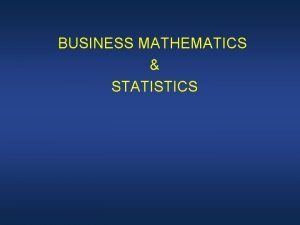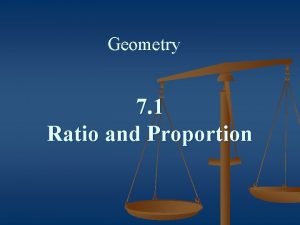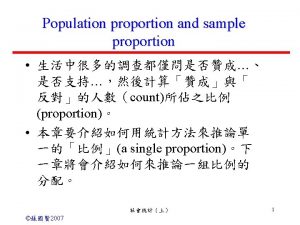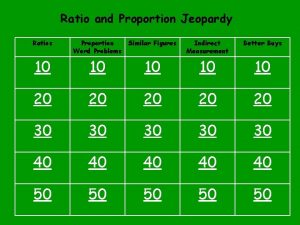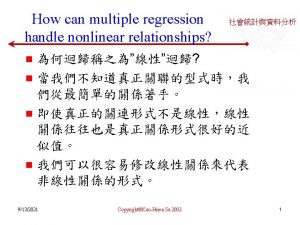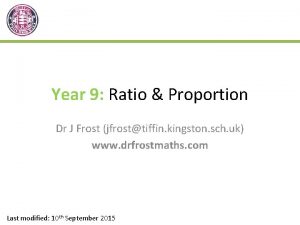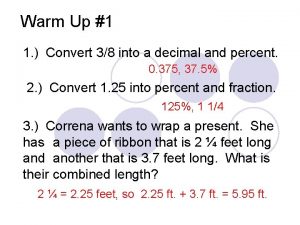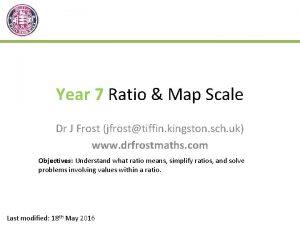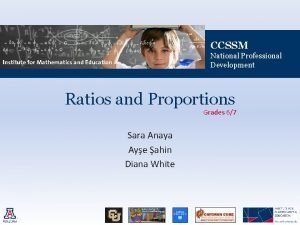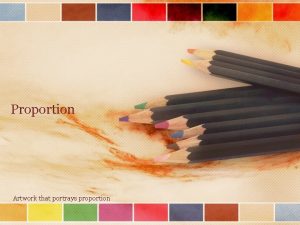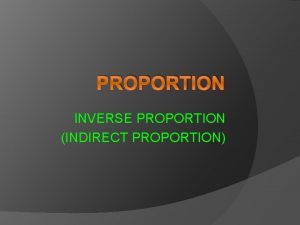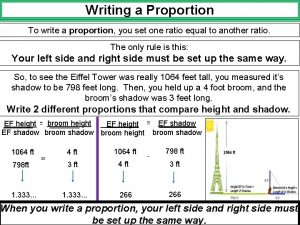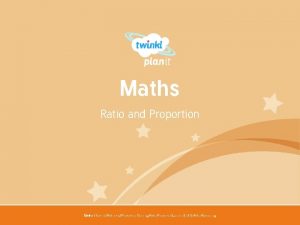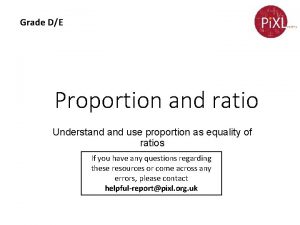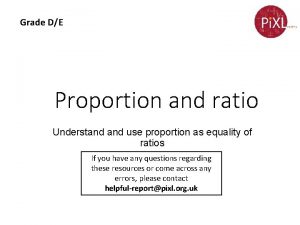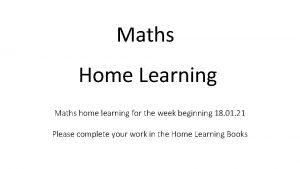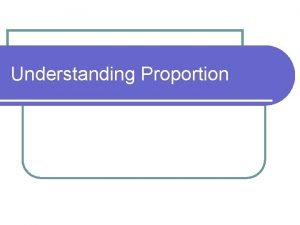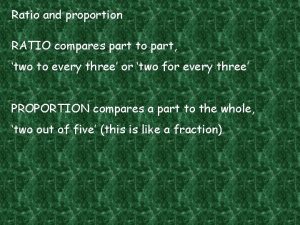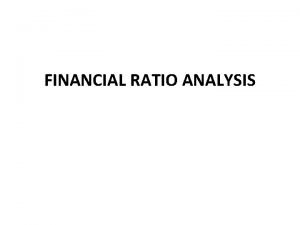Maths Home Learning Week 4 Ratio Proportion Maths

















- Slides: 17

Maths Home Learning Week 4 Ratio & Proportion

Maths Home Learning Week 4 Ratio & Proportion Lesson 1 Proportion is comparing the size or amount of one thing to another. For example, when you do a drawing, you have to make sure the trees are in proportion to the people.

Maths Home Learning Week 4 When making recipes, we often have to increase or decrease the amount of ingredients to suit different numbers of people. This soup recipe is for 1 person. Fill in the table to show the amount of ingredients for other numbers of people: For 1 Person 2 potatoes Ratio & Proportion 8 carrots Lesson 1 250 ml 100 g beans water 16 celery sticks For 2 People For 4 People For 12 People For 25 People For 100 People For 34 people

Maths Home Learning Week 4 This time, the recipe for soup is for 6 people. How would you make sure you only made enough for 1 person? Draw a table and show much of each ingredient would be needed for: 1 person: 3 people: Ratio & Proportion Lesson 1 9 people:

Maths Home Learning Week 4 Ratio & Proportion Lesson 1 Finally, have a go at this problem.

Today we’re looking at Scale Factors. A Scale Factor is used when you increase or decrease the size of something. Let’s start with shapes. Maths Home Learning Week 4 Lesson 2 Scale Factors If you don’t have squared paper, just pretend each square measures 1 cm and measure the shapes instead.

Lesson 2 Scale Factors Have a go at these Scale Factor problems.

Maths – Week 4 Lesson 3 Calculating Scale Factors Today we will carry on looking at Scale Factors. Today we’re going to find the scale factors based on things that have already been increased or decreased in size. All of these problems can be solved using your times tables. Often you just need to count the squares in the pictures or use your factors.

Maths – Week 4 Lesson 3 Calculating Scale Factors Solve these problems using your factors.

Maths – Week 4 Lesson 3 Calculating Scale Factors For an easy, fun drawing challenge, follow this link: https: //nrich. maths. org/47 85 For a harder challenge: You might be familiar with the different sizes of paper. Above are the sizes of paper in a picture. Can you explain how the sizes relate to each other? For example, how big is A 4 paper compared to A 1?

Today we will be focussing Ratio shows the relationship between two values or quantities, for example in a bag of sweets there are 2 blue sweets for every 1 red sweet. This would mean there was a ratio of 2 to 1. This can be written as 2: 1. Ratio can be a tricky topic so you might want to have a look at this BBC Bitesize site before tackling the problems. https: //www. bbc. co. uk/bitesize/topics/zsq 7 hy c Maths Home Learning Week 4 Ratio Lesson 4

Have a look at these pictures and write out the sentences to show the ratio: a) Maths Home Learning Week 4 Ratio Lesson 4 b) c) For every 6 apples there are ____ pears. For every 2 apples there are ____ pears.

a) Maths Home Learning Week 4 Ratio Lesson 4 b) Problem solving time: c) I create a pattern using blue, green and red counters. Every time I place 6 blue counters, I put 2 green counters and 3 red counters. If I use 21 red counters, how many blue ones will I use? How many green ones will I use? How many counters will I use in total? d) I make a fruit juice cocktail using orange juice and pineapple juice. I use 1 part orange juice to 3 parts pineapple juice. If there is 1 litre of just in total then how much of each juice have I used?

Maths – Home Learning Week 4 Lesson 5 – Ratio & Proportion For our final lesson of the week, we are going to begin using the ratio symbol. The ratio symbol is a colon that separates the numbers, e. g. 2: 1

Maths – Home Learning Week 4 Lesson 5 – Ratio & Proportion Match the ratio to the diagrams or description. My pattern has 20 red counters and 60 blue ones. 2: 1 I have £ 8 and my friend has £ 4. 1: 3 My pattern has 9 red counters and 15 blue ones. 2: 3 4: 1 3: 5

Maths – Home Learning Week 4 Lesson 5 – Ratio & Proportion

Maths – Home Learning Week 4 Lesson 5 – Ratio & Proportion Finish the week off with one of these problems: A) https: //nrich. maths. org/8422 B) https: //nrich. maths. org/4793 C) https: //nrich. maths. org/6870 Choose 1 problem or if you want a challenge pick 2 or even 3!
 Week by week plans for documenting children's development
Week by week plans for documenting children's development How to calculate ratio and proportion
How to calculate ratio and proportion Ratio and proportion difference
Ratio and proportion difference Ratio and proportion examples
Ratio and proportion examples Ratio in the form 1 n
Ratio in the form 1 n Business mathematics ratio and proportion
Business mathematics ratio and proportion Quiz 1: ratios, properties, and proportions
Quiz 1: ratios, properties, and proportions Trapezoid ratio and proportion
Trapezoid ratio and proportion Properties of proportion
Properties of proportion Confidence interval proportion
Confidence interval proportion Proportions jeopardy
Proportions jeopardy Ratio and direct proportion
Ratio and direct proportion Dr frost proportion
Dr frost proportion Inverse variation proportion
Inverse variation proportion How to solve ratio and proportion
How to solve ratio and proportion Ratio map scale
Ratio map scale Ratio and proportion for use after section 7-2
Ratio and proportion for use after section 7-2 Ratio and proportion
Ratio and proportion



